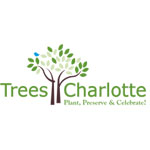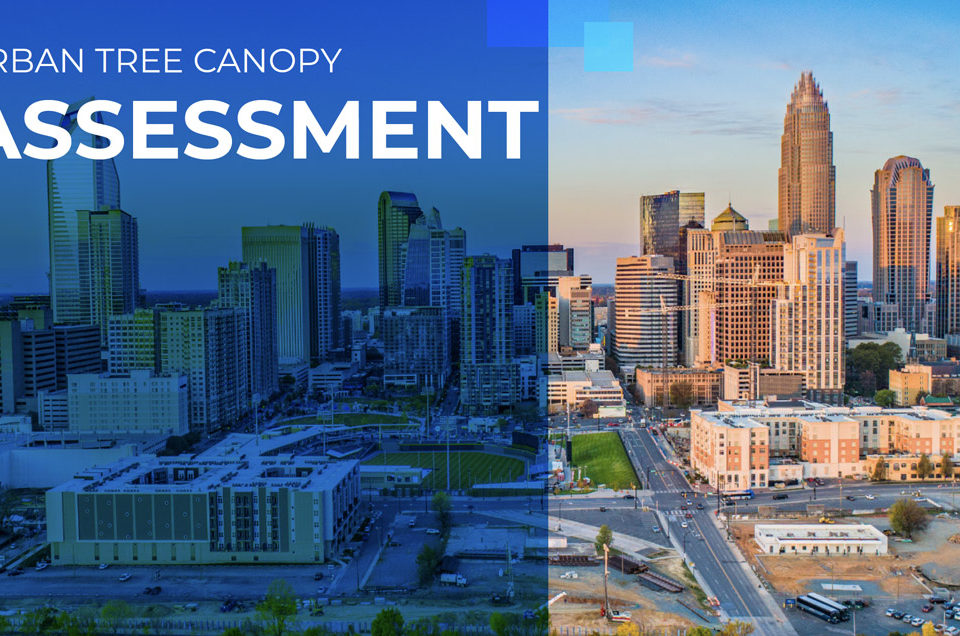Our Tree Heritage
Trees Save Energy
4.08.15
4th Annual Tree Canopy Action Summit
5.07.15
Our Tree Heritage
By Amy Rogers
From an airplane descending into Charlotte, it’s hard to believe there’s a city of nearly one million people living below. Only when the uptown skyscrapers come into view is there evidence of what Charlotte has become: a city in a forest.
Visitors and residents alike will often marvel at the magnificent willow oaks and other trees that give the city so much of its beauty and character. But even longtime Charlotteans may not know just how different the Queen City once appeared, back in the early days before the modern era of development and the resulting growth that surrounds us today.
Across rugged land known as backcountry with few navigable rivers, settlers traveling the Great Wagon Road from the northern colonies through the Carolina Piedmont in the 1700s were guaranteed a tough journey. Their records documented ash, chestnut, oak, pine, poplar, and walnut trees among the flora and fauna. Where their route crossed that of Indians and traders making treks to the coast, “Charlotte Town” was founded, and incorporated in 1768. Four “wards” were delineated around the crossing. Drawings from the era show settlers hard at work clearing dense stands of trees and sawing them into logs to build dwellings, fences and other structures. Cleared land could then be farmed.
Life was hard, and it’s unlikely that settlers had the luxury of enjoying trees for their natural splendor. Travel remained treacherous, so in 1820 citizens were asked to help improve commerce by building roads out of wooden planks they cut from split logs.
Charlotte’s growth was mostly confined to the four wards until the textile industry arrived and fueled development at the end of the 19th century. The creation of suburbs to house a growing population followed. Some of the most verdant areas today, such as Myers Park, Elizabeth, and Dilworth were nothing more than farmland with next to none of the tree canopy they boast now. The photos dating back to this time and place are startling: They show vast expanses of open land, completely devoid of the trees that would be planted in years to come.
City leaders used great foresight when envisioning Charlotte’s growth. As early as 1910, a group of Charlotte leaders and private citizens had formed a Tree Commission, according to Dr. Tom Hanchett, staff historian at Levine Museum of the New South. From the streets laid out in a grid pattern in Dilworth to the curved boulevards of Myers Park, development plans dating back to the early years of the 20th century wisely included ample green space in the form of neighborhood parks. Landscape architects John Nolen, Earle Sumner Draper, and the Olmstead brothers garnered national attention with their work that gave shape to Charlotte. Workers delivered trees by wagon and planted them along the streets of the burgeoning neighborhoods. “That love of trees became integral to the city’s character,” says Hanchett. After World War II, veterans and their young families began to put down roots, literally and figuratively, as they built new homes and planted trees in their yards during this era of growth.
Trees belong to everyone. And while we may appreciate the many ways that trees benefit the community at large, very few are on public land, only about 5% to 6%. Rolfe Neill, a member of the TreesCharlotte Board of Directors, says, “Most of the things we value or enjoy, we take for granted. Often, they’ve been here when we arrived; we assume ‘somebody’ is taking care. Actually, only a very small number of people are involved in taking care of our trees.”
TreesCharlotte is a collaboration of public and private partners. It works to engage private property and business owners in efforts to plant trees, tend to their health, and assure their longevity. Since its inception in 2012, TreesCharlotte has planted more than 22,000 trees at a cost of hundreds of thousands of dollars.
“The city plants 5,000 to 10,000 trees yearly out of tax dollars,” Neill adds. He cautions, “That number won’t keep up with tree death by disease, storm, old age and development clearing. Only by pro-active management can we preserve the tree canopy and its many benefits.”
The term canopy refers to “the layer of leaves, branches, and stems of trees that cover the ground when viewed from above.” The many advantages of a healthy tree canopy are well documented. Among them are better air quality, less storm water runoff, higher property values; plus cooler streets and buildings, which results in lower energy costs.
It might not seem that Charlotte would have much in common with the metropolis of New York City or the Pacific Northwest destination of Seattle. But like those cities, Charlotte has been named one of the Ten Best Cities for Urban Forests by American Forests, the oldest national non-profit conservation organization in the U.S. The recognition is awarded to cities that implement plans that assure the health, protection, diversity, canopy coverage, and sustainability of their trees.
Despite use of the term “urban forest,” each city’s plans must extend to stewardship of public parks and open spaces as well. Charlotte has also been named a Tree City USA, a designation given by the Arbor Day Foundation.
For all their majesty, our canopy trees aren’t indestructible, a fact dramatically evident when storms or high winds send the giants toppling. It’s estimated that the city lost 88,000 trees as a result of Hurricane Hugo in 1989.
In some parts of Charlotte, half or more of our towering willow oaks are now in poor health. Many of our trees are reaching the end of their natural life-span and will need to be replaced. Some of these, along Queens Road, comprise what Hanchett calls our “miles-long green cathedral.”
What’s more, with growth comes development. Charlotte is moving away from building the sprawling suburbs that were popular in prior generations. Don McSween, recently retired Charlotte City Arborist says, “The unfortunate trend now is to go to smaller and smaller lots and denser housing, which leaves little room for the trees we are known for. The development of 10 acres of woods will remove more trees than the city plants in a year.”
But through TreesCharlotte, Charlotteans are working hard, not just to maintain our canopy but to increase it with private funding and community involvement. Canopy coverage today is estimated at 47%. The goal is to reach 50% by 2050. That three percent may not sound like much, but it’s a half million trees.
This spring, eight area schools participated in tree plantings to celebrate Arbor Day. Jack Meckler is an outdoor enthusiast and a longtime supporter of tree conservation. As a TreeMaster volunteer and a Central Carolinas Master Naturalist, he took part in the planting at Olde Providence Elementary School. He welcomes others to participate. “We can plant 200 trees on a Saturday,” Meckler says. He stresses that no experience is needed.
Caring for our trees and assuring they remain vibrant for future generations preserves our legacy and benefits us all. Becoming part of Charlotte’s heritage is easy. “Anybody can do this,” says Meckler, inviting volunteers to join TreesCharlotte as future plantings occur. “You just have to arrive with a pair of gloves and boots.”
For more information or questions about TreesCharlotte contact Tammy Seigel at tammy@treescharlotte.org.

